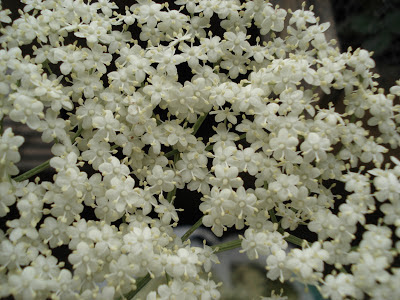Pretty Little Things
It's the season for elderflowers. There is a spot near my house that I have dubbed 'the one stop shop' because of its ten mature elders, wild cherry trees, and scrubby blackberry bushes. But you won't catch me confessing its whereabouts! The flowers are so abundant that I went a little overboard. Not so much that the future berry harvest is in jeopardy, but overboard all the same... I wanted to have enough for a batch of cordial as well as a few fritters.
Depending on where you live, elders will flower anywhere between mid-May and late June. The European (Sambucus nigra) and the North American (Sambucus canadensis) elders are separate species, but to be honest there is little to distinguish the two. Either one is a medium to large, and rather elegant shrub. If you find one, you should be able to spot an entire stand, as they tend to spread like weeds. Should you be in the market for an elder for your garden, keep in mind that the European elder comes in several decorative versions, including one with purpley-black leaves.
When picking elderflowers, try to avoid fading flowers: if the petals rain down when you grab a bunch, it is too far gone. In fact, you get the best flavour from bunches that are about a third unopened. The following recipe has a high enough sugar content to keep for a few months, as long as the cordial stays in the refrigerator, however, freezing it will give it an indefinite shelf life. The extra citric or tartaric acids also act as preservatives, but are not essential. Citric acid can be found in pharmacies or in natural food shops (in the gluten-free baking aisle). Tartaric acid can be found in hobby wine shops, but if you cannot find it, you may be able to get away with substituting it with 2 teaspoons of cream of tartar.
Elderflower Cordial
Recipe adapted from the River Cottage books
Yields about 2L/67.6 fl oz
25-30 elder flower heads
3 unwaxed or organic lemons
1 organic orange
1.5 kg/3.3 lbs sugar
2 tsp citric or tartaric acid (optional)
Pick through the flowers and remove most of the stalks. Though this step is not necessary, I usually take this time to ensure that there are no bugs in the flowers. Try to do this over a bowl to collect any falling pollen, as it packs a lot of flavour.
Place all the flowers in a large bowl or pot. Add the zest of the lemons and orange, and cover with 1.5L/50.7 fl oz of freshly boiled water.
Cover the pot, and let sit overnight, or until the infusion cools completely.
When cool, pass through a scalded muslin or jelly bag. Squeeze out as much liquid as you can. Return to the pot, adding the sugar, the juices of the lemons and orange, and the citric or tartaric acid if using.
Bring up slowly to a low boil, and let simmer gently for about 5 minutes, all the while stirring to make sure that the sugar dissolves.
Pour through a clean muslin again.
Use a funnel to pour the hot cordial into sterilised bottles. Seal the bottles, and let cool completely before storing in the fridge.
To serve the cordial, dilute one part syrup to about 5 parts still or sparkling water. Elderflower cordial is also quite lovely in gin based cocktails or over strawberries and rhubarb. This method can probably be used to make cordial with other flowers, such as roses, lilacs, or violets.
Bon app'!





Comments
Post a Comment